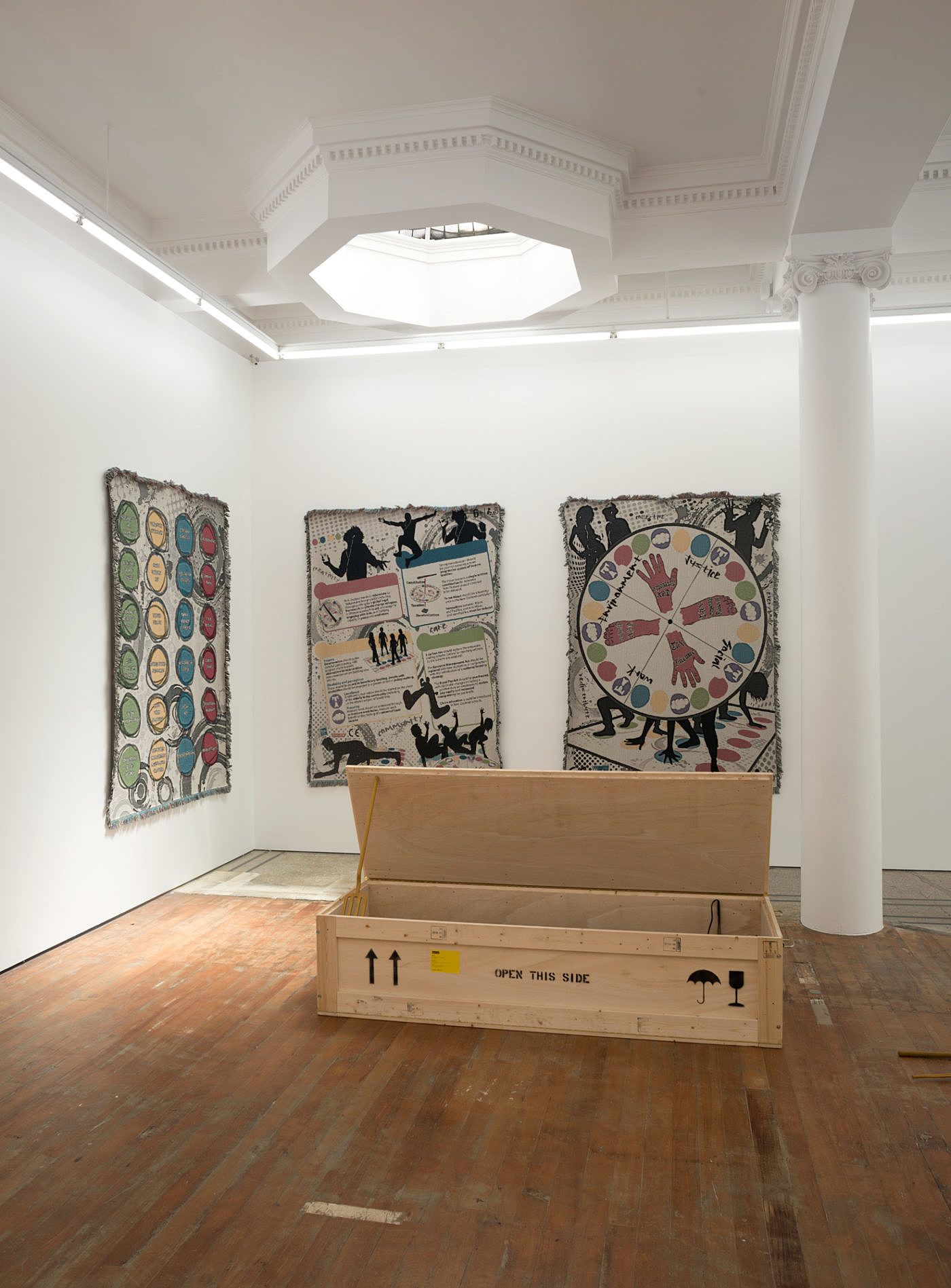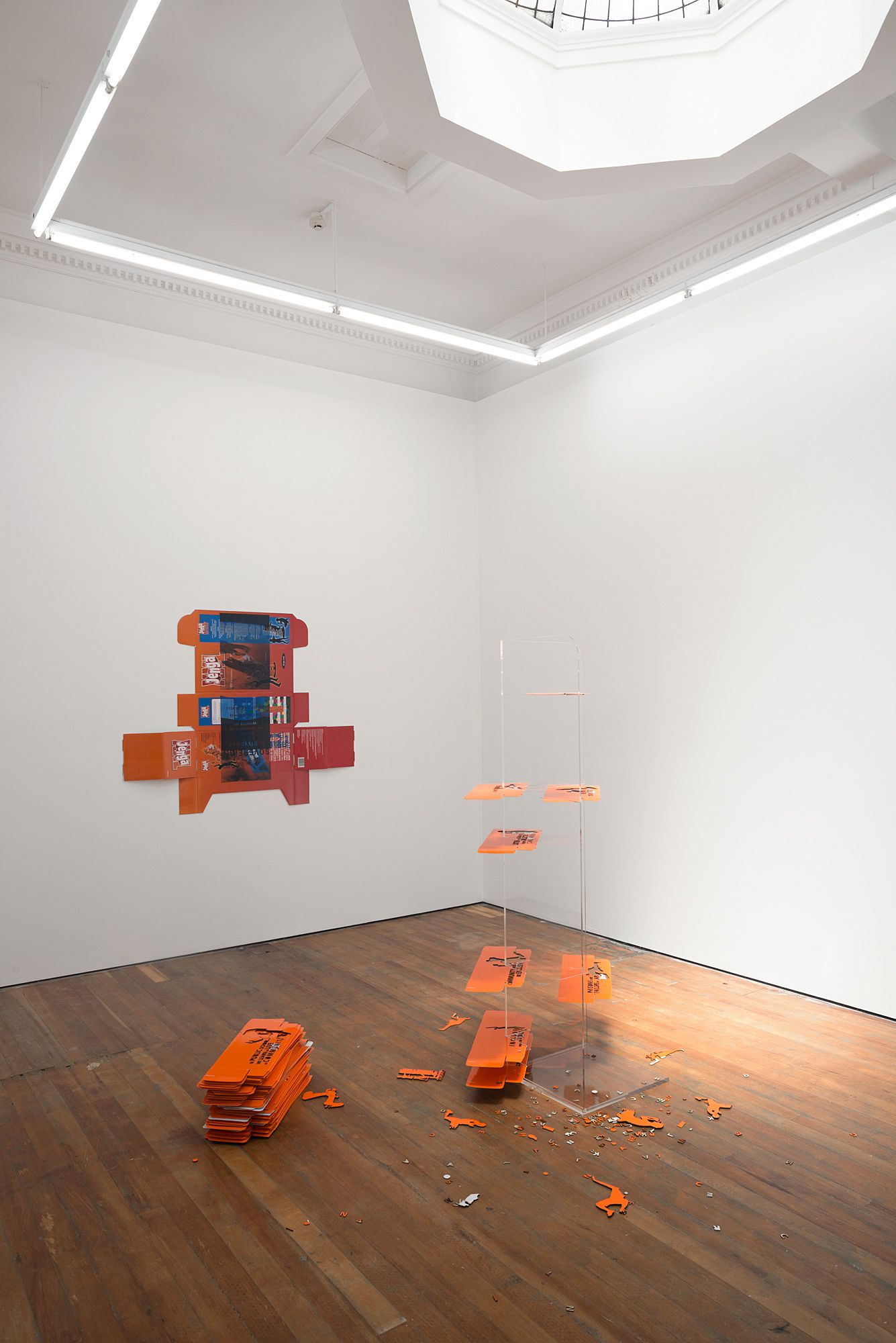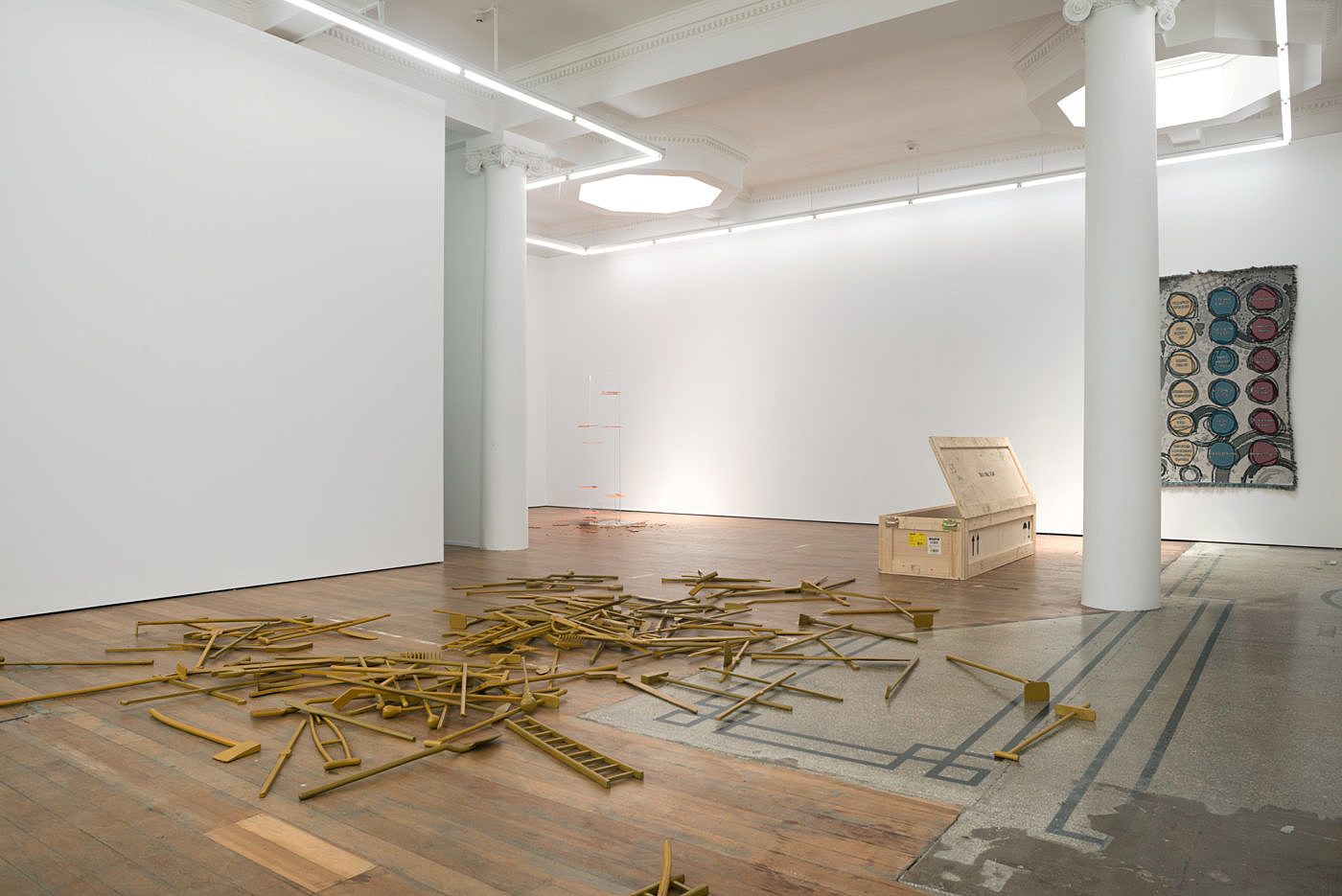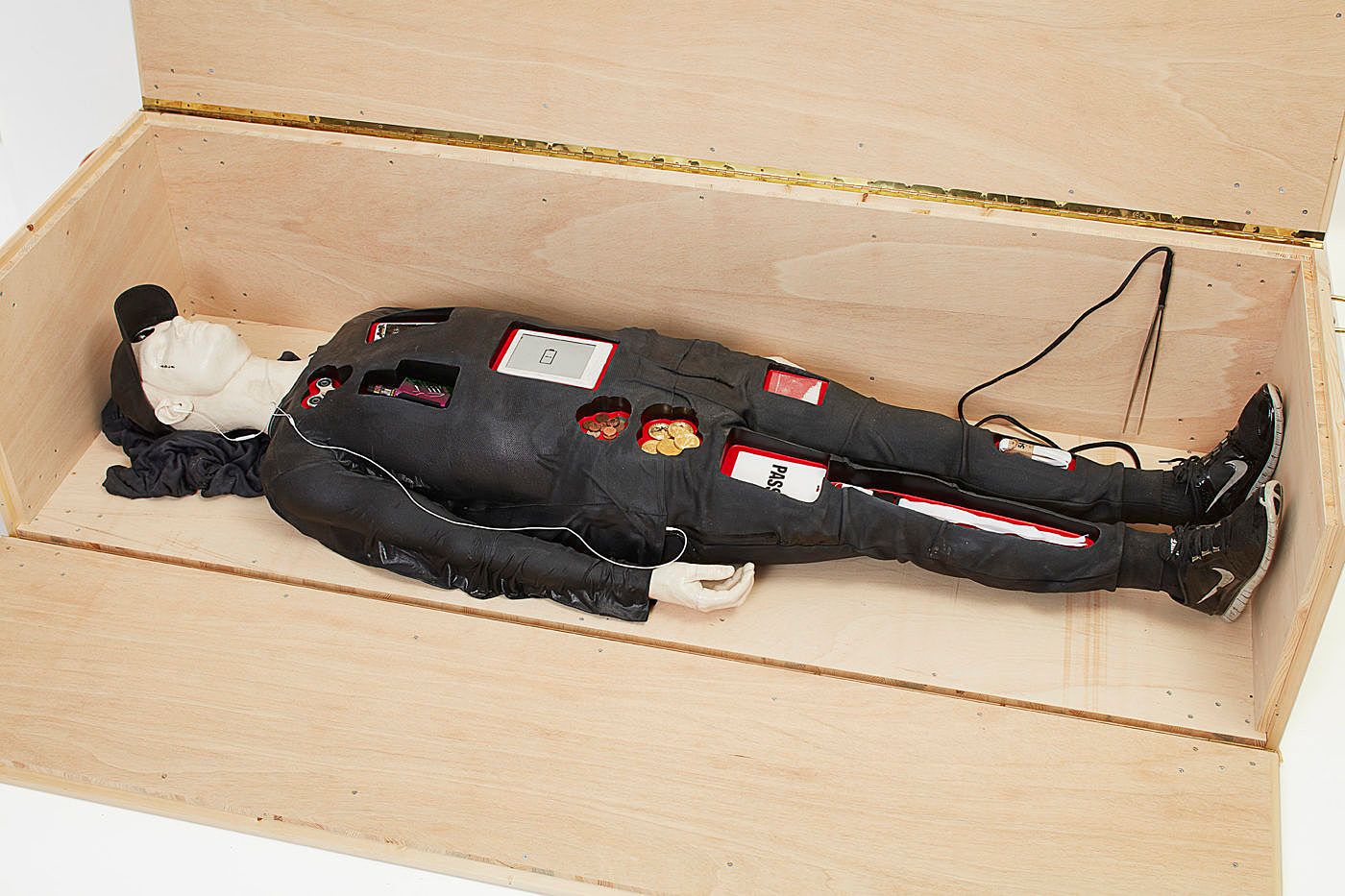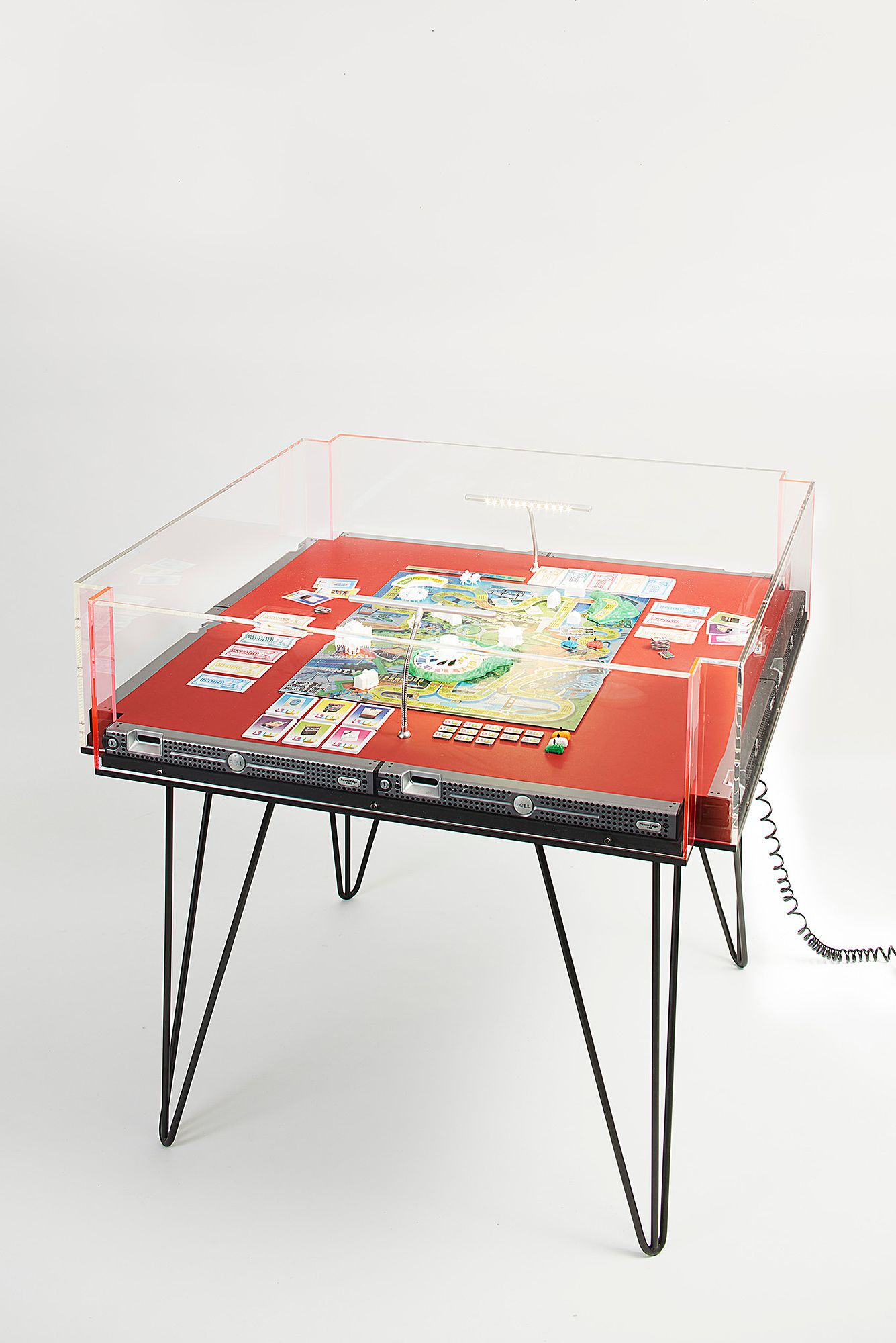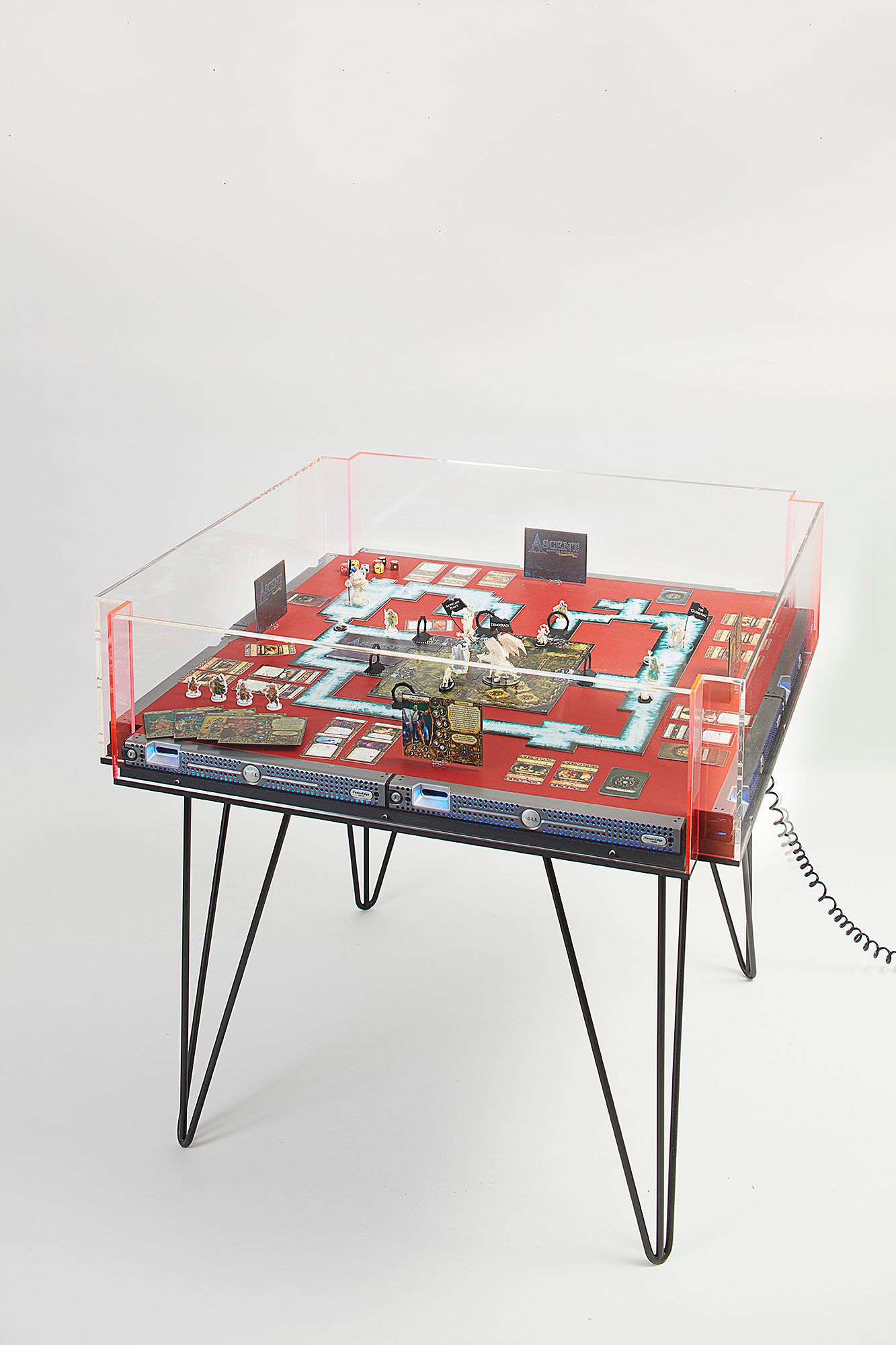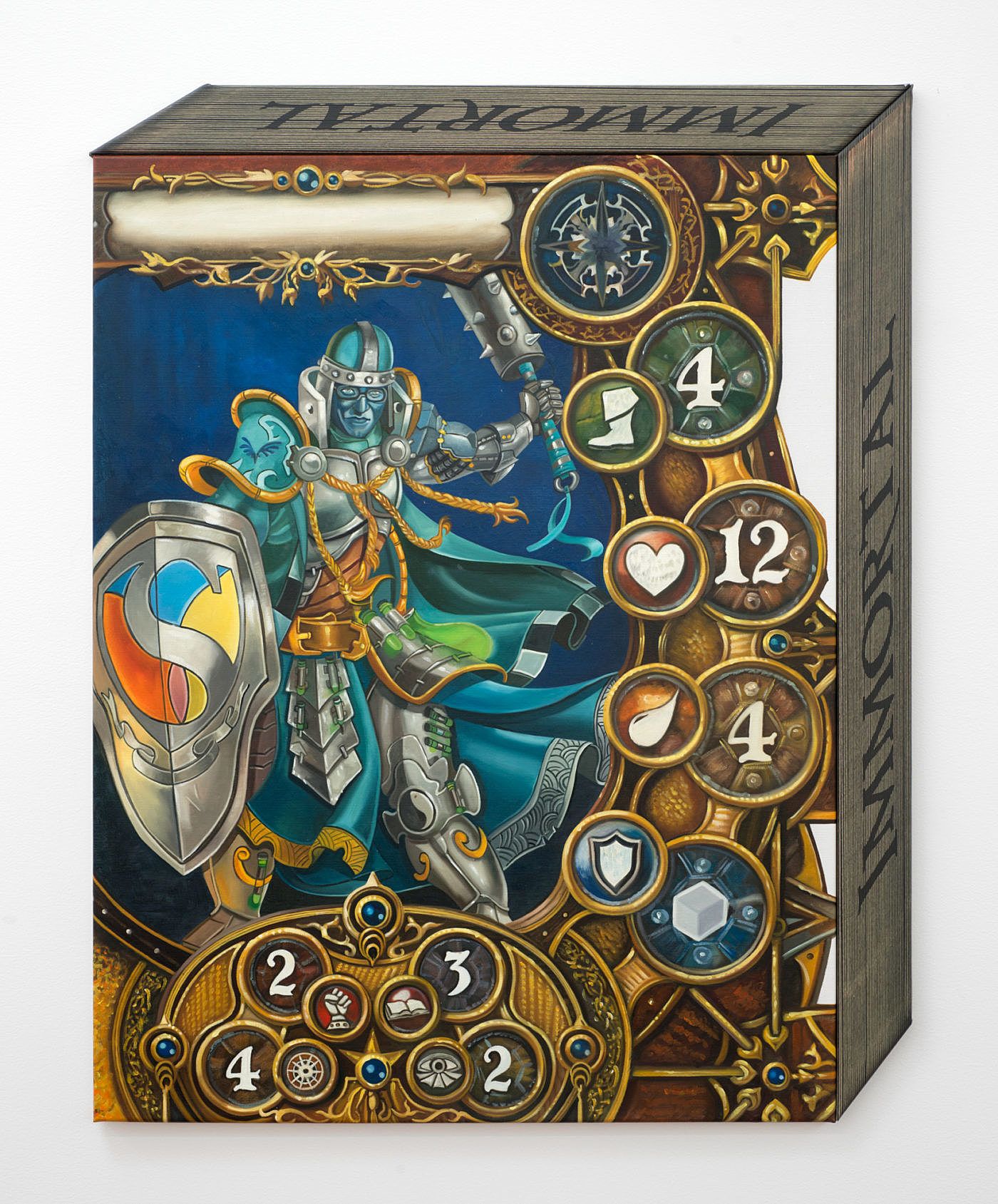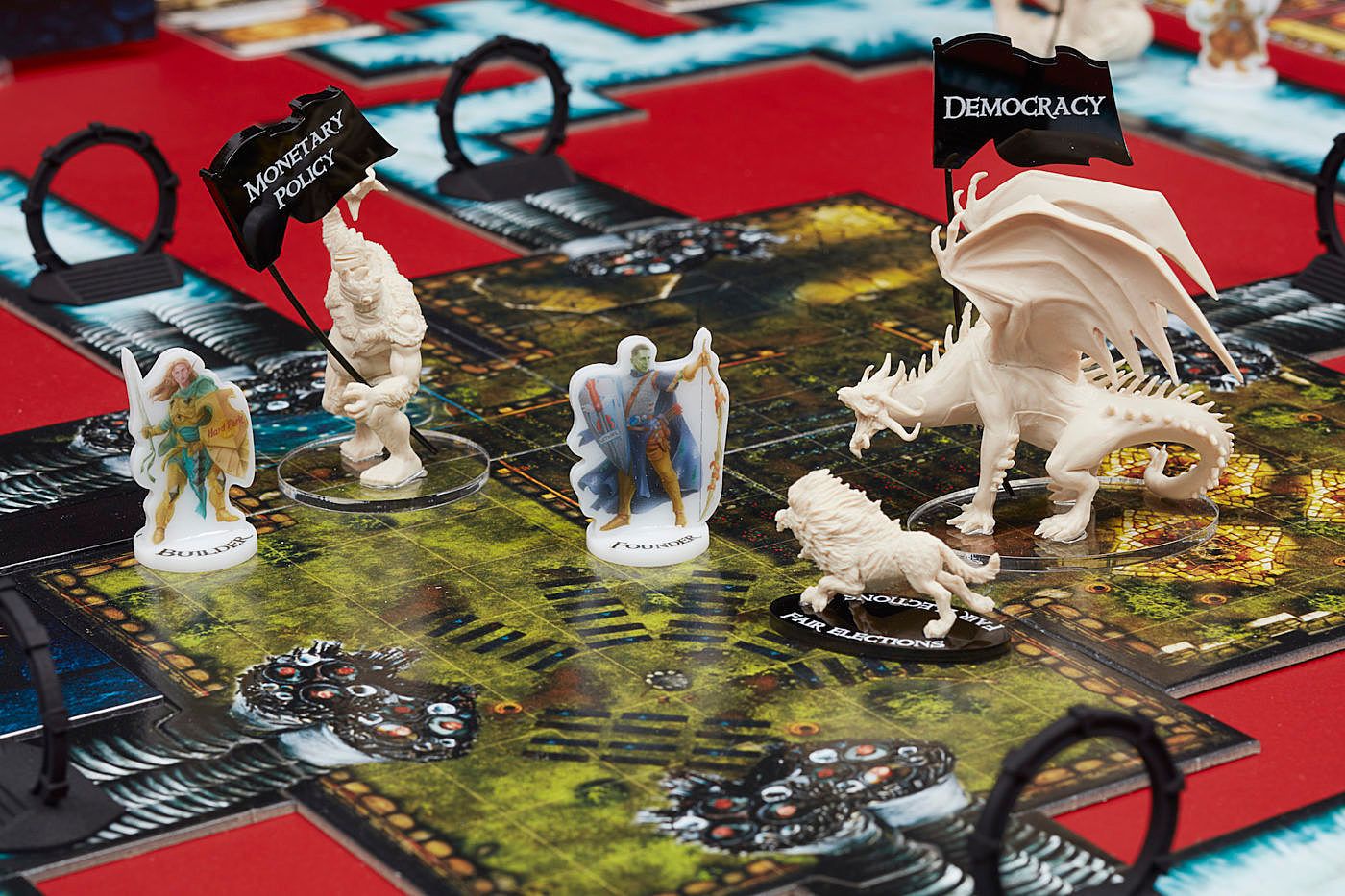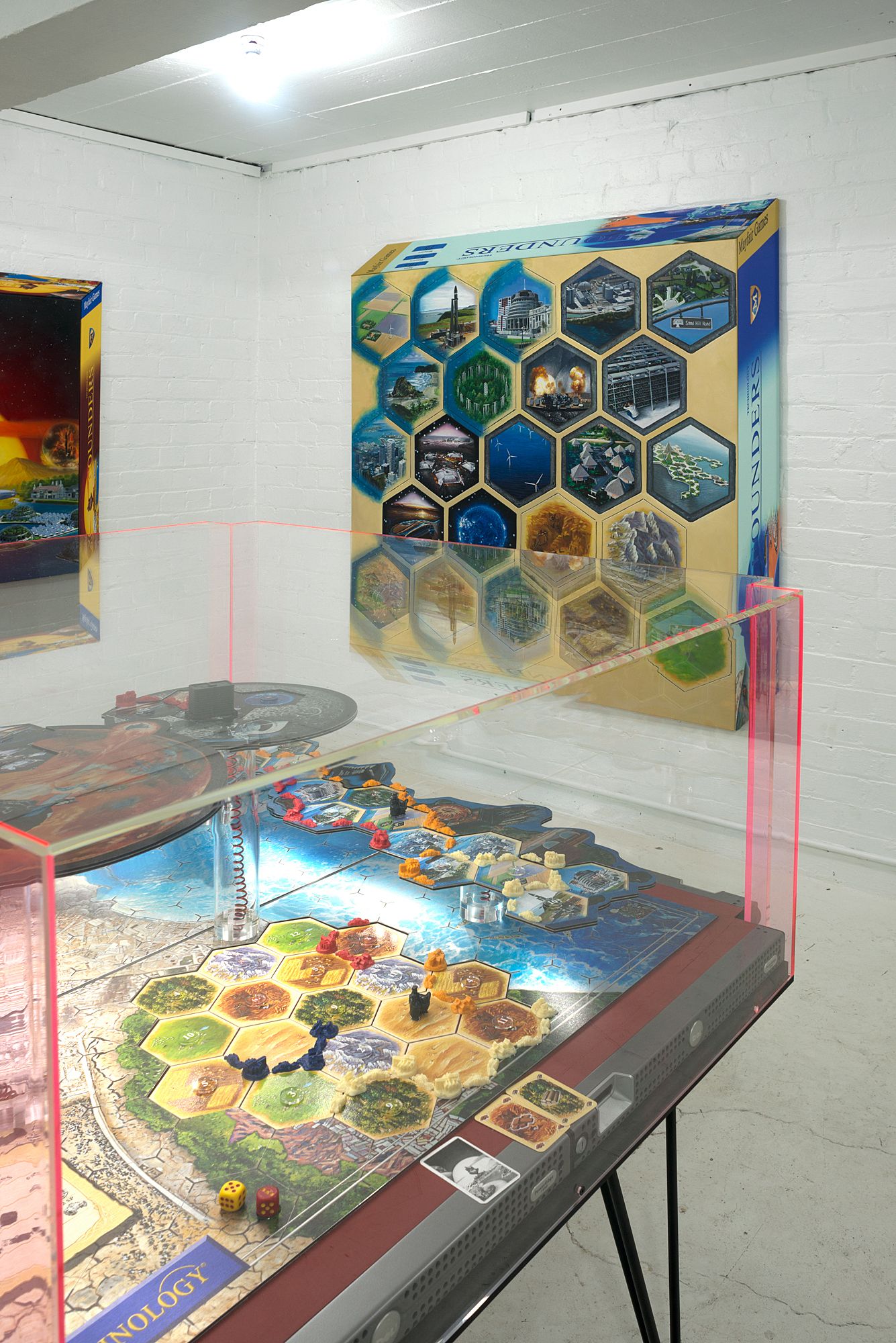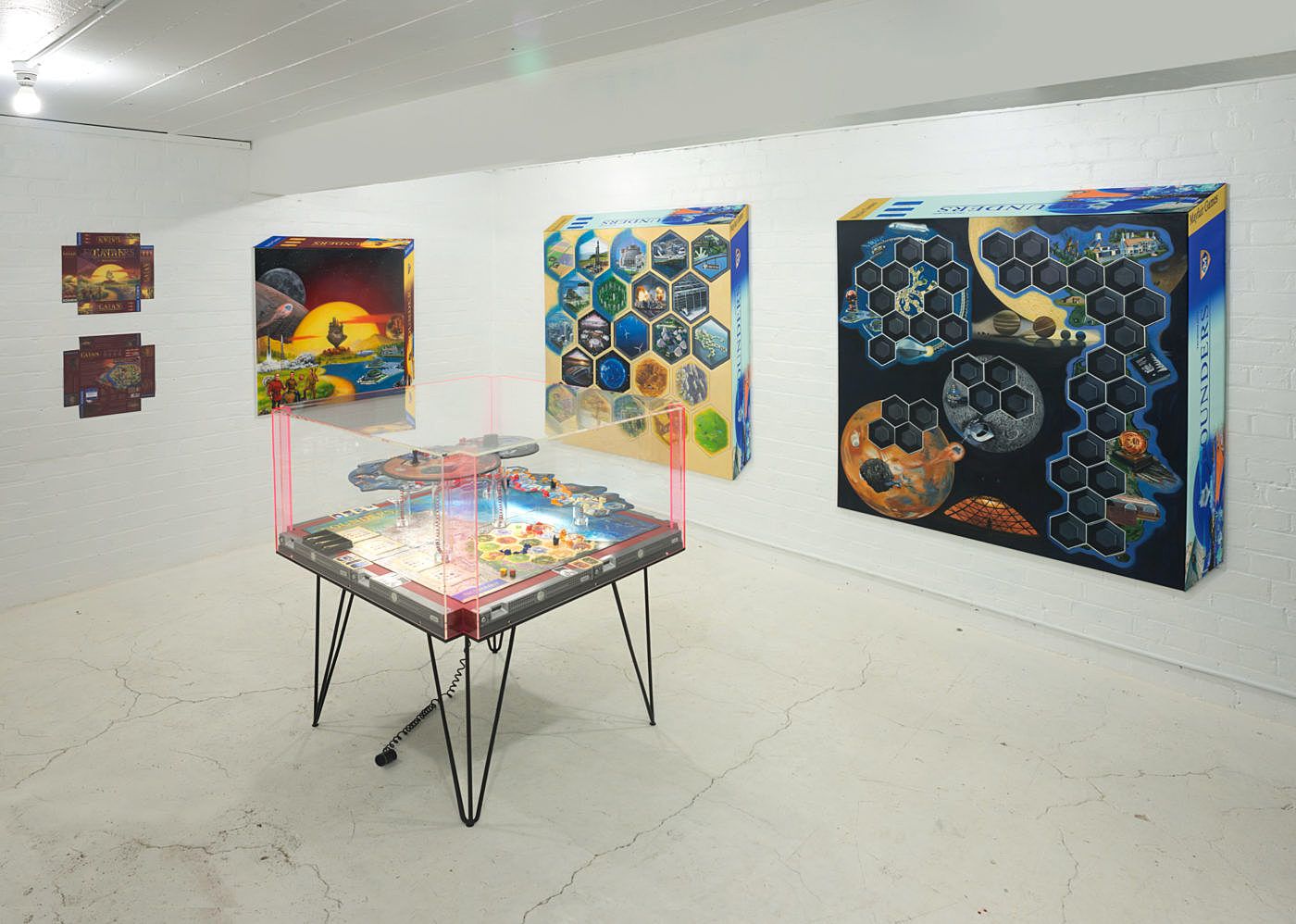A Competition of Ideals: A Review of Simon Denny's 'The Founder's Paradox'
Francis McWhannell asks whether the real Simon Denny might be standing up.
Francis McWhannell asks whether the real Simon Denny might be standing up.
While I really want to draw attention to certain arguments and things I think have a lot of cultural importance in the world, to say something resolute – like, this is this way or that’s that way – I find really hard to do. I don’t interact with the world like that, and I don’t feel like that about things in the world. My craft is exhibition-making. That is really what I do … I really value art, and it’s art for a reason.
Wandering round Simon Denny’s latest show, The Founder’s Paradox, at Michael Lett in Auckland, I find myself thinking of a similarly titled episode from Malcolm Gladwell’s Revisionist History podcast, The Satire Paradox. In the episode, Gladwell discusses what he perceives to be failed satire: satire that does not make its position sufficiently clear and so loses its bite. He offers several examples. Tina Fey’s imitation of Sarah Palin comes under fire for being too charming, too easy for Palin to co-opt and turn into ‘good sport’ capital (one wonders what Gladwell would make of Thomas Sainsbury’s Paula Bennett, subsequently embraced by the politician). Gladwell also criticises Stephen Colbert’s caricature of a conservative pundit on The Colbert Report, suggesting that it was so ambiguous that it even managed to appeal to conservatives, who misread the show as a satire on liberals.
It is not unusual for those discussing Denny’s work to comment on its slipperiness, its refusal to assume a particular position. As the above epigraph attests, the artist himself has done this. Writer Anthony Byrt – whose researches helped to shape The Founder’s Paradox – does so at the beginning of a lengthy text in the catalogue for the show, observing that when Denny treats his favourite subject, the contemporary tech world, “it’s rare for him to make a declarative ‘this is good and this is bad’ statement”. Byrt further notes (accurately) that this lends Denny’s practice honesty, by acknowledging that it is part of “a globalised art world system that is itself a product of exactly the neoliberal economic forces that have brought about the virtual monopolies of tech-capitalism”. One might equally observe that a measure of ambivalence is quite reasonable when one is dealing with complex questions.
It is not unusual for those discussing Denny’s work to comment on its slipperiness, its refusal to assume a particular position … However, what strikes me about The Founder’s Paradox is not the extent to which it is slippery, but instead the extent to which it isn’t.
However, what strikes me about The Founder’s Paradox is not the extent to which it is slippery, but instead the extent to which it isn’t. Denny does not here retreat into shoulder shrugging. Rather, he gets very close indeed to adopting a stance. The Founder’s Paradox contrasts two opposing ideological systems that offer potential ‘next steps’ to follow the third way centrism found today in many countries, including Aotearoa. The first system is ‘fourth way’ collectivism, particularly as outlined in The New Zealand Project (2017) by local thinker Max Harris. The second is libertarian individualism, particularly as outlined in Zero to One: Notes on Startups, or How to Build the Future (2014) by German-born American entrepreneur (and New Zealand citizen) Peter Thiel, and in a favourite book of his, The Sovereign Individual (1999), by ‘investment advisors’ James Dale Davidson and Lord William Rees-Mogg.
In order to explore the competing ideologies, Denny makes use of the game – not the computer game, as one might expect given his long-term interest in all things digital and internet, but the boxed variety, the ‘parlour game’, which is apparently experiencing great popularity at present. (This is not the artist’s first use of the game. For example, his 2016 show Blockchain Future States – which explored the technology underlying Bitcoin – included a version of Risk.) Denny wittily plays on the fact that economic or political ideologies are so often embedded in games, whether or not we realise it (consider, for instance, Monopoly, originally called the Landlord’s Game, which was created by Elizabeth Magie as a tool for teaching players about the evils of monopoly). The ground floor of Michael Lett plays host to two bodies of work that reimagine Twister and Jenga XXL as games that promote collectivism.
Fourth Way Silhouette Twister wall weavings (dated 2017, like all the Denny works on show) takes the form of three large hangings: one for the instruction sheet, one for the spinner, and one for the mat. Denny redesigns the already minimally competitive Twister as a cooperative, society-strengthening game. The instructions comprise a series of propositions for the betterment of Aotearoa derived from The New Zealand Project, including decarceration, decolonisation, and environmental protection. As players plant their hands and feet on the familiar coloured spots, they engage with such problems as agricultural emissions, educational inequality, and homelessness, and activate such novel solutions as an alternative metric to GDP, a universal basic income, and a Zero Carbon Act.
The work is easily one of the most compelling in the exhibition, at least to this broadly liberal writer who loves a good weaving. Its form feels highly appropriate, both evoking a coming together, and recalling the old relationship between progressive thought and craft-based art (think, for instance, of the relationship between socialism and the Arts and Crafts movement). The hangings possess a pleasing tactility, furthering the notion – already suggested by the choice of game – that collectivism can include a sensual dimension. Playing Twister need not be erotic. After all, it is designed to be played by children as well as adults. However, the work reminds me that leftist thinking has long held that social cooperation can be strengthened by physical engagement, including sex (the free-love movement of the mid 20th century is just one example). In Denny’s Twister, adults mash bodies for the good of the group.
The theme of cooperation continues in the similarly titled, if rather less elegant, Fourth Way Silhouette Jenga Display Prototype. Like Twister, this work depends on Harris’s ideas for a politics of care, creativity, and community to replace centrism. Here, maxims such as “fight inequality in education” (an exhortation both to close gaps and to deemphasise the white worldview), “widen the Overton window” (allow for more radical thinking, especially in government), and “include neglected voices” (especially the voices of people of colour and the poor) are laser-cut into flat Jenga XXL boxes. These are ostensibly ready to be made up into the building blocks of an ascending tower. There are no new instructions, but one suspects that the idea is to build a tower together that doesn’t fall over.
Harris’s thinking is naturally underpinned by certain assumptions. Chief among these is the idea that colonisation is implicated in a great many problems of the present, including grave inequalities and environmental degradation. The issue of colonisation shows up not only in Denny’s works, but also in a multi-piece sculpture by Michael Parekowhai, Acts III (2015), which features prominently in The Founder’s Paradox (indeed, it’s the first thing one encounters when entering the exhibition). The inclusion of the work is further appropriate because it explores a game (Parekowhai has been playing with games and their latent ideologies for years now), and because Parekowhai taught Denny at art school and continues to influence his practice.
Acts III comprises a series of bronze implements. Most are fashioned after items found in Jacks Straws, a kind of variation on Pick-Up Sticks (which, incidentally, Parekowhai has also treated) employing elongated versions of such objects as axes, crutches (Acts 3 in the Bible includes the healing of a lame beggar), guns, rakes, and two-man saws. Parekowhai’s work gets at the pervasive nature of colonial history, since a good many of the items carry fairly obvious colonial baggage. It also alludes to the indoctrination of Māori into Pākehā notions of what is ‘right’, as well as to questions of cultural collision and appropriation; among Parekowhai’s objects is a lobed bar that immediately recalls a koru as famously ironed out by Gordon Walters (possibly by chance, a Walters koru-like motif also shows up in Twister).
By literally ceding the floor, the Pākehā Denny also puts into practice the politics espoused by Harris (while Parekowhai is a well-known figure, Māori artists in general arguably remain marginalised), and suggests that he is aligned with those politics. It’s a strong statement, surprisingly so for one who is not known for assuming a firm position. At the same time, though, Denny does not offer an unqualified endorsement of Harris’s ‘Fourth Way’. In fact, a number of elements are retained that problematise the framework, that question its tenability. Among the most obvious of these is the inclusion, in both Twister and Jenga, of images derived from a well-known campaign for the Apple iPod: silhouetted figures of indefinite cultural/ethnic/racial identity, who dance enthusiastically to music being piped into their ears by way of pure white devices and headphones.
Inequality is made worse by rampant disunity. On the right, white nationalism and other forms of xenophobia, distrust of career politicians and non-conservative media, and a loathing for all things ‘progressive’ are manifestly on the increase. On the left, there is no shortage of bickering among people of basically common vision.
In the context of the iPod campaign, the figures ostensibly conveyed a positive, inclusive message, in line with – to borrow a phrase of Harris’s – “a politics of love”. They suggested that the iPod was for everyone to use, regardless of identity. Apple cast itself as the supplier of digital products for a liberated, colour-blind age, in which everyone was subsumed by a happy unity. Ghosting Denny’s games, however, the silhouette motif also presents a challenge to collectivism, not only because it stems from a notion of technology as emancipator that is associated with tech-world libertarianism (on which more later), but also because it is at odds with the present historical moment – at least as characterised by liberals, who must inevitably acknowledge the unreality of cultural/ethnic/racial equality, even if this remains a goal of theirs.
Inequality is made worse by rampant disunity. On the right, white nationalism and other forms of xenophobia, distrust of career politicians and non-conservative media, and a loathing for all things ‘progressive’ are manifestly on the increase. On the left, there is no shortage of bickering among people of basically common vision. At the same time, many of us are plagued by anxiety, or more specific mental health issues, desperate to fit in, to look a certain way, to own all the desirable things, all the seemingly necessary accoutrements of everyday life. Should we get what we crave, we might still find ourselves weighed down by debt, or strangely lonely, a feeling only exacerbated by a life lived insulated from others, their noises cancelled out by headphones, their opinions and emotions screened out by algorithms that narrow our worlds rather than expand them.
This state of affairs is alluded to in Operation. Based on the eponymous game, the work centres on a rather crude effigy of Denny in an art crate-cum-coffin, dressed head to toe in art bro-cum-hacker black. His body is riddled with mod cons: an iPhone (with busted screen), a vaporiser, a Kindle, nootropic powder (a cognitive function enhancer), more of those white Apple headphones, even a fidget spinner. The work immediately evokes the ambiguous nature of our relationship with such things, suggesting that they have become so deeply integrated into daily life that they are like parts of the human body, but that we sometimes suspect we’d be better off ridding ourselves of them. While the notion wins on verity (many of us experience the push-pull of technology), it’s also kind of a banality; it feels a bit glib.
Of course, Denny might be going for glibness, burlesquing the angst of the comfortable digital-age intellectual, burlesquing himself as a vaunted post-internet artist. But the work doesn’t entirely land for me. A more convincing criticality is present in Jenga and Twister. The child-friendly nature of the original games and the visual simplicity of Denny’s versions contrast the complexity of Harris’s ideas and the difficulty of actually putting them into practice. Jenga is a game in which the tower ultimately falls, when players get overly ambitious, or lose sight of what is realistic. Together with the silhouetted figures, these qualities do a good job of hinting at the idealistic nature of Harris’s thinking. But Denny does not negate its value altogether. He is not really engaging in satire here. Instead, he acknowledges the challenges to the vision, and leaves room for its reshaping in accordance with the pressures of our present reality.
If the typical liberal worries about the technology-hastened diminishment of the social (cooperative and empathetic) dimension of the human being, and the challenges presented by a colonial backstory, the typical libertarian does not.
However, the way in which our present reality is understood is not homogenous. If the typical liberal worries about the technology-hastened diminishment of the social (cooperative and empathetic) dimension of the human being, and the challenges presented by a colonial backstory, the typical libertarian does not. Such a person might accept environmental degradation as a real and present danger, but she or he is likely to dismiss, downplay, or ignore outright other legacies of the past, and is likely to view technology and the individual as solutions, rather than problems. Moving down into the basement of Michael Lett (which, rather appropriately, houses a former bank vault), libertarian individualism enters the story with force, featuring in a trio of uncanny imitations of board games.
Denny uses a version of the Game of Life to treat the tension between collectivism and individualism (itself often associated with ‘game theory’). There are a small number of attendant canvas-based works, but the centrepiece is a prototype of Denny’s game, executed in materials of archival quality; the board, for instance, is of printed aluminium. The whole lies on a custom-made table, bordered by Dell server casing, and covered by a Plexiglas case. The expected cards, cars, money, and spinner are all present, but substantial changes have been made. There are wholly new instructions. Players (and Denny has confirmed that the game, unlike those above, is playable) are living out the life of a Stanford-educated entrepreneur, deciding whether to pursue a collective future or individual sovereignty – whether to “Hold hands or shake the Invisible Hand”.
The work is both amusing and eminently clever. Denny casts Facebook’s Mark Zuckerberg as the game’s mascot, styling him after the figures found on an existing version of the game from Germany (the artist’s place of residence for the past decade). Game of Life: Collective vs Individual successfully embodies the oscillation between collectivist and individualist ideals in which many of us are engaged. Like Jenga and Twister, it is informative, providing visitors who know nothing about the ideologies with a concise summary of their principles, and even offering up a short reading list: Mark Fisher and Timothy Morton for collectivism, Friedrich Hayek and Ayn Rand (of course) for individualism. Interested visitors can also turn to Byrt’s writings in the aforementioned catalogue (this is styled, in appropriately gamey language, as a “compendium”), but the work itself stands fairly comfortably on its own.
Game of Life is more visually rich than Jenga and Twister; it includes more bells and whistles. This is ostensibly due to the fact that the original is a more complicated game, for older players. However, it also gestures towards a capitalist interest in money and things that is downplayed by Harris. If Twister appeals with its materiality, Game of Life appeals with its materialism. This places it in league with a suite of works created around Descent: Journeys in the Dark, a 2005 fantasy board game cut from the same cloth as the roleplaying game Dungeons and Dragons and the card game Magic: The Gathering. Denny reimagines Descent in more optimistic terms as Ascent: Above the Nation State, in which individualist heroes fight to “Escape the constraints of the Nation State and establish Global Domination”. (Rather ironically, the heroes work together to achieve success.)
Underpinned by a vision of unfettered private wealth, the presentation boasts a profusion of stuff. Again, the central work is an elaborate prototype, but Denny also includes a large number of oil paintings featuring the heroes. These were commissioned from a Chinese company called Royal-Painting.com, which otherwise produces hand-painted copies of well-known works of art for hotels and the like. Used to create cards for the game, the paintings also stand as discrete art objects. Each is bordered by two digitally printed rhomboid canvases, turning it into a mock box lid. The mode of production attests to our already globalised world, marked as it is by outsourcing to China, and to the persistence of the old-fashioned handmade into the tech present. The digital frames the manual.
To the eyes of someone who has never been more than gamer-adjacent, the paintings represent perfect imitations of what seems always to be called fantasy ‘art’, whether or not it feels in any sense artful. The works are materially poor; several of the printed canvases, for example, are beginning to wrinkle. This nastiness, a sharp contrast with Twister, gets at something of the mismatch between surface appearances and underlying (lack of) integrity that dogs the current moment, in art as elsewhere (Ikea, I’m looking at you). The paintings are at once sophisticated works of fine art, produced conceptually by Denny, and tawdry commodity pieces, produced physically by anonymous talents who are ultimately cogs in a machine – and one that owes as much to the free market as to the Chinese state. They’re compellingly repellent.
So too are the champions of libertarianism created by Denny. These are based on influential tech-world figures, including Satoshi Nakamoto, the shadowy founder of Bitcoin; Laura Deming, a pioneer of life extension technology (the Operation Denny might also be read as a body on the road to bionic immortality); and, most importantly, Thiel. (By chance, Thiel also features in a show by Michael Stevenson at Auckland Art Gallery Toi o Tāmaki.) In his text, Byrt describes Thiel’s position in a global network of similarly minded entrepreneurs (including Deming, whose researches he has sponsored), as well as his various connections with Aotearoa. For instance, Thiel provided seed money for the local software company Xero, and his business Palantir is associated with New Zealand defence and intelligence agencies (which were also a focus of Denny’s 2015 Venice Biennale exhibition, Secret Power).
As Byrt makes clear, Thiel is a complicated figure. He was an early supporter of Trump (I’m afraid he had to come up at least once), despite the fact that the President’s nationalistic, protectionist views are nominally at odds with Thiel’s free-market tendencies and his belief that the nation-state is an outmoded structure. However, he shares Trump’s generally contrarian attitude and his scepticism towards proponents of ‘politically correct’ discourse. A quick Google throws up a YouTube video in which Thiel dismisses the introduction of principles of diversity into tertiary education institutions as a stifling of free thought. He suggests that diversity policies might create the appearance of heterogeneity, but that they are, in fact, underpinned by a homogeneous anti-western doctrine. In Thiel’s mind, they are essentially more rules to be avoided.
Denny’s Ascent takes the ideals of tech-world libertarianism to an extreme, styling innovation and personal freedom as absolutely good – heroes to the monsters of democratic government and regulation. The choice of the fantasy genre is not accidental. It gets at the connection between geek and tech culture, suggesting that so many teenagers maligned as losers for their enthusiasm for fantasy have become so many leaders of contemporary industry. There is the suggestion that the self-identified outsider, rejected by the plebs, is now in a position to take charge, to assert his or her (usually his) rightful status of superiority. Thiel is relevant not only because he is a tech-world leader, but also because he is an avowed fan of the ur-fantasy text The Lord of the Rings by J. R. R. Tolkien (the company name Palantir derives from the all-seeing stones found in the books).
At the same time, the medievalist tone of the game reveals the retrograde nature of the libertarian vision of a future sans nation-state. This may be ‘radical’, but it’s no newer than the principles underpinning collectivism. It depends essentially on the example of feudalism. Entrepreneurial capitalists take the place of the monarchs of old, reigning over serf-like producer-consumers. Taxes on the rich revert to tithes on members of the general public. The primary difference is that the powerful are elevated on the basis not of blood or military strength but of ‘intellectual superiority’, reflected in business success. As with the iPod campaign, there is the pretence that identity is irrelevant, that anyone can make it. However, in the absence of an equal starting point, and in a system that views extreme self-interest as a virtue, those who already enjoy privileges (connections, wealth, whiteness) look set to win.
A final suite of works in The Founder’s Paradox continues the theme of ascent, while adding a literal dimension. Based on the Settlers of Catan (created by the German game-maker Klaus Teuber), Founders is the most visually elaborate of the games, featuring a fantastic multi-tiered board. Players assume the role of individualist moguls attempting to escape the environmentally degraded earth of the near future, progressing first to New Zealand, second to floating islands, and third to the moon and Mars. Again, Thiel is a key figure, having purchased land in Wanaka, and having invested in both seasteading (the term derives from the libertarian ‘homestead principle’) and space exploration. Again, he appears in the iconography of the game, this time as one of the eponymous founders.
Denny’s interest in libertarian magnates who would use New Zealand as a bolthole is not new (see, for instance, The Personal Effects of Kim Dotcom from 2013), but here it finds more forceful expression. In his text, Byrt points out that Aotearoa appeals to such people not only because of its physical advantages (isolation, plentiful water, sparse population), but also because it is known for ‘pioneering’ ideas radical in their time. As every good New Zealander knows, this was the first country in the world to establish universal suffrage. More importantly, for the individualist thinker, it is remarkable for its fast and enthusiastic adoption of free-market deregulation in the 1980s and ’90s. Byrt attempts to be balanced in his discussion. He’s not out to rail against neo-liberalism. But one gets the distinct impression that he views individualism as deeply dubious, and Thiel and his ilk as downright dangerous.
Ultimately, the idea that stability, let alone flourishing, might derive from the unfettered maximisation of self-interest emerges as an absurdity.
Founders allows for some ambiguity. There is a seductive futuristic quality to the display, which puts me in mind of 20th-century visions of the world to come. Denny does not deny the potential value of human-made islands and space stations. It is worth noting that seasteading is sold both as sustainable, and as a solution to the displacement of Pacific Island people as a consequence of rising sea levels. However, his overall position is hardly less clear than Byrt’s. As with Ascent, the goal of Founders is patently nefarious. We are meant to register and reject the neo-colonial agenda of men like Thiel. Moreover, while he does not dismiss libertarian thinking altogether, Denny certainly undermines the utopian grand narrative, and much more forcefully than he does upstairs. Ultimately, the idea that stability, let alone flourishing, might derive from the unfettered maximisation of self-interest emerges as an absurdity.
I’m fond of speaking of the ‘transition exhibition’, one that doesn’t necessarily represent an unmitigated success, but that is manifestly moving – if you’ll excuse the business-speak expression – in a positive direction. The Founder’s Paradox is such a show. Formally, it seems to lack some of Denny’s famed meticulousness. Peering at the prototypes, I spy blobs of glue that do not, to my mind, enrich the experience, though it’s entirely possible that these were included intentionally (perhaps to reinforce the sense of the works being robust one-off showpieces ready for the trade fair circuit?). Less justifiable are a series of editorial errors: a stray letter that should be bold, a hyphen that should be an en dash. These are obviously minor niggles, and I’d be reluctant to mention them but for the fact that they support a general sense that the exhibition isn’t quite up to the standard Denny has set for himself.
I find myself wishing that the show were cleaner and less clean, more refined and less explicit. There’s a lot going on. To some extent, this is inevitable. Denny is a maximalist, who aims to acknowledge the profusion of information that washes over us every day. But The Founder’s Paradox seems to me to lay things on a bit thick, in a way that doesn’t enhance its power or sophistication. I suspect a little pruning would have been advantageous – perhaps of some of the canvas-based works, which tend to overwhelm the more important and more intriguing prototypes. Equally, relative to previous work I’ve seen by Denny, the exhibition shows less of a lightness of touch. There’s the encroachment, in places, of a certain blatancy that makes the show feel less artful than it might otherwise have been.
Still, The Founder’s Paradox is not lacking in admirable qualities. It presents, in a staunchly audience-friendly manner (you don’t need to know your Baudrillard or your Marx to get something out of this show), two competing ideologies that have the potential to impact greatly upon Aotearoa. Moreover, it shows Denny stepping up his ambition, not merely creating a show that is seriously rich, has serious wow factor, but attempting – in a moment of high confusion, and as an artist who finds it hard to “say something resolute” – something approaching a Gladwell satire in art. In The Founder’s Paradox, Denny’s coolness seems to wobble, like a Jenga tower that’s really reaching for the sky. There’s a quality of agitation to the exhibition, which suggests that the artist has never really been dispassionate, despite the slickness of so much of his output, despite what you might have heard.
There’s a quality of agitation to the exhibition, which suggests that the artist has never really been dispassionate, despite the slickness of so much of his output, despite what you might have heard.
In an article titled ‘The Founders’ Paradox’ for the magazine Inc., Leigh Buchanan suggests that “start-ups require you to be at once hugely selfish and hugely selfless”. I do not think that Denny’s show is an exploration of this notion, nor an instantiation, another enterprise from the entrepreneur-artist. Rather, it seems to me to hint at a different paradox altogether: that the self can be nourished by apparently selfless acts, not so much because these ‘feel good’, but because they better the community on which the individual naturally, logically depends. Denny will probably never come out and say such a thing explicitly. Nor should he. The declarative statement doesn’t always go well with art. But I won’t be sorry if he continues to do as he does here, teasing out his attitudes with a balance of earnestness and humour – even if he never buries his tech-world persona.
All images are courtesy of Michael Lett and the artist.
The Founder’s Paradox
Michael Lett
18 November to 22 December 2017
Free admission

